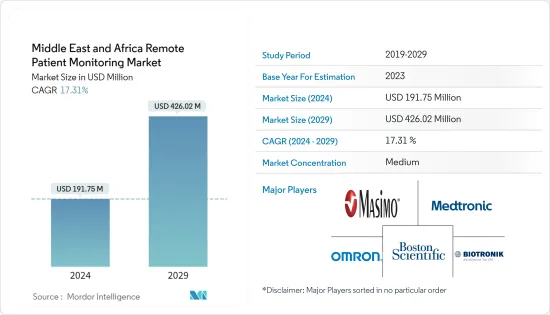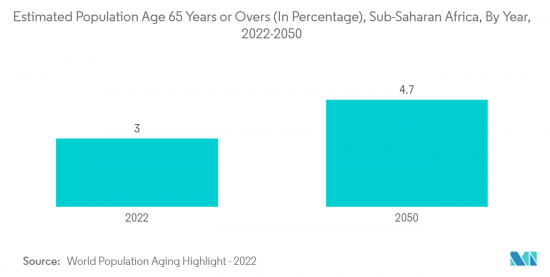PUBLISHER: Mordor Intelligence | PRODUCT CODE: 1403750

PUBLISHER: Mordor Intelligence | PRODUCT CODE: 1403750
Middle East & Africa Remote Patient Monitoring - Market Share Analysis, Industry Trends & Statistics, Growth Forecasts 2024 - 2029

The Middle East & Africa Remote Patient Monitoring Market size is estimated at USD 191.75 million in 2024, and is expected to reach USD 426.02 million by 2029, growing at a CAGR of 17.31% during the forecast period (2024-2029).
The COVID-19 pandemic placed enormous pressure on hospitals and healthcare systems that were understaffed and overworked. Remote patient monitoring technology helped patients remain safe within their homes while reducing stress on hospitals, emergency rooms, and front-line healthcare workers during the pandemic, thereby positively impacting the market. According to an article published by Pharmacy Practice, in June 2022, pharmaceutical care in the UAE changed after COVID-19 in terms of medication dispensing, patient-centered roles, and remote services. Also, from the early beginnings of the pandemic, the UAE issued regulations to facilitate the delivery of healthcare services remotely in community and hospital pharmacies. Remote patient monitoring has demonstrated the ability to enhance health outcomes and reduce chaos during the pandemic which made the hospitals realize the advantage of RPM over traditional systems. Hence, the demand for remote patient monitoring systems increased, eventually driving market growth.
Factors such as rising incidences of chronic diseases due to lifestyle changes and rising demand for home-based monitoring devices are driving the growth of the market. For instance, per an article published by the National Library of Medicine in March 2022, the growing prevalence of non-communicable chronic diseases (NCDs) is placing increased pressure on healthcare systems, mainly primary healthcare. Many patients with NCDs do not receive treatment that meets their needs, even in well-managed integrated delivery systems. Therefore, the increasing NCDs and the improved healthcare systems demand remote patient monitoring devices and are expected to drive market growth.
In addition, these devices are compact and portable, and patients can wear them all day without feeling uneasy. These devices also ensure that the patient's condition is monitored continuously. Growing demand for home-based monitoring devices also boosts the market's growth. According to the Center for Medicare and Medicaid Services, 2021, several high-risk patients can prolong their healthy days at home and avoid being readmitted to the hospital because of remote monitoring. Remote monitoring clients report a 76% decrease in readmission rates, an average patient satisfaction rating of 89%, and overall medical cost savings of almost USD 370 million in the previous year.
Thus the above-mentioned factors are expected to drive the growth of the market over the forecast period. However, resistance from healthcare industry professionals toward the adoption of patient monitoring systems and lack of proper reimbursement are the factors impeding the market's growth.
Middle East & Africa Remote Patient Monitoring Market Trends
Heart Monitors are Expected to Witness a Rapid Growth During the Forecasted Period
A heart monitor is a device that helps the patient record the heart's electrical activity (ECG). This device is about the size of a pager. It records the heart rate and rhythm. The increased death rate due to cardiovascular diseases across developed countries, coupled with the increased geriatric population and developing countries, have raised awareness among the patient population to opt for early and easy-to-monitor devices, which is expected to drive the segmental growth. For instance, according to Saudi Health Ministry statistics, in 2021, 15% of the Saudi population suffered from hypertension, a risk factor contributing significantly to cardiovascular diseases. With the increasing cases of cardiovascular diseases, the pressure on the government increases to take initiatives to treat these diseases, boosting the market growth in the country. Moreover, according to the World Heart Federation Updates from July 2021, Africa is home to more than 1 billion people and is a major contributor to the global burden of cardiovascular disease. Further, the increasing burden of cardiovascular diseases in the region is expected to increase the burden of cardiovascular diseases in the country, which will further boost the growth of the segment.
Also, according to Stats South Africa's latest Financial statistics of the consolidated general government report published in August 2021, the total South African government spending bill was R2 trillion in the 2019/20 financial year. This translates to 12.1% of total general government spending, making it the fourth biggest expenditure item after general public services, education, and social protection. Similarly, most health services in South Africa (about 86%) are provided through the public sector, yet only about 50% of health expenditure comes from the government. Thus, the increasing healthcare expenditure is expected to uplift the market in the coming years.
Thus, the above-mentioned factors are expected to contribute to segmental growth over the forecast period.

Gulf Cooperation Council (GCC) is is Expected to show a Significant Share of the Market Over the Forecast Period
The Gulf Cooperation Council (GCC) includes countries such as Riyadh and Saudi Arabia, Bahrain, Kuwait, Oman, Qatar, Saudi Arabia, and UAE. Some factors, such as the increasing geriatric population and rising prevalence of chronic disorders, coupled with technological advancements, are propelling the market growth in this region. According to a new study commissioned by Cleveland Clinic Abu Dhabi in September 2021, an integral part of Mubadala Health, to mark World Heart Day, more than a thousand UAE residents revealed that 55% of respondents had been directly affected by heart disease, either through being diagnosed themselves (12%), having a close friend or family member diagnosed with heart disease (53%), or both. Cardiovascular disease is the leading cause of death in the UAE, with symptoms in patients often occurring a decade earlier than their counterparts in other developed nations. Thus, the increasing cases of cardiovascular diseases in the region are expected to increase the demand for remote patient monitoring systems over the forecast period.
Moreover, in March 2022, BioIntelliSense and Mubadala Health established a strategic collaboration to enable a continuous care model for medical-grade remote monitoring and management. Similarly, in January 2022, Ortus iHealth launched a pioneering new remote monitoring platform at Arab Health 2022. Such collaboration and product launches are expected to further boost the growth of the market in the region over the forecast period.
Thus, all aforementioned factors are expected to boost the market in the region over the forecast period.
Middle East & Africa Remote Patient Monitoring Industry Overview
The Middle East & Africa remote patient monitoring systems market is moderate due to the presence of companies operating globally and regionally. The competitive landscape includes an analysis of a few international and local companies with significant market shares. It is well known, including Boston Scientific, Masimo, Medtronic Plc, Omron Healthcare, and Biotronik among others.
Additional Benefits:
- The market estimate (ME) sheet in Excel format
- 3 months of analyst support
TABLE OF CONTENTS
1 INTRODUCTION
- 1.1 Study Assumptions and Market Definition
- 1.2 Scope of the Study
2 RESEARCH METHODOLOGY
3 EXECUTIVE SUMMARY
4 MARKET DYNAMICS
- 4.1 Market Overview
- 4.2 Market Drivers
- 4.2.1 Rising Incidences of Chronic Diseases Due to Lifestyle Changes
- 4.2.2 Rising Demand for Home-based Monitoring Devices
- 4.3 Market Restraints
- 4.3.1 Resistance from Healthcare Industry Professionals Toward the Adoption of Patient Monitoring Systems
- 4.3.2 Lack of Proper Reimbursement
- 4.4 Porter's Five Force Analysis
- 4.4.1 Bargaining Power of Suppliers
- 4.4.2 Bargaining Power of Buyers/Consumers
- 4.4.3 Threat of New Entrants
- 4.4.4 Threat of Substitute Products
- 4.4.5 Intensity of Competitive Rivalry
5 MARKET SEGMENTATION (Market Size by Value - USD)
- 5.1 By Type of Device
- 5.1.1 Heart Monitors
- 5.1.2 Breath Monitors
- 5.1.3 Hematology Monitors
- 5.1.4 Multi-Parameter Monitors
- 5.1.5 Other Types of Monitors
- 5.2 By Application
- 5.2.1 Cancer Treatment
- 5.2.2 Cardiovascular Diseases
- 5.2.3 Diabetes Treatment
- 5.2.4 Sleep Disorder
- 5.2.5 Weight Management and Fitness Monitoring
- 5.2.6 Other Applications
- 5.3 By End User
- 5.3.1 Home Care Settings
- 5.3.2 Hospital/Clinics
- 5.3.3 Others
- 5.4 Geography
- 5.4.1 GCC
- 5.4.2 South Africa
- 5.4.3 Rest of Middle East and Africa
6 COMPETITIVE LANDSCAPE
- 6.1 Company Profiles
- 6.1.1 Abbott Laboratories
- 6.1.2 Boston Scientific Corporation
- 6.1.3 Biotronik
- 6.1.4 GE Healthcare
- 6.1.5 Honeywell International Inc.
- 6.1.6 Medtronic Plc
- 6.1.7 Nihon Kohden Corporation
- 6.1.8 Koninklijke Philips N.V.
- 6.1.9 Masimo Corporation
7 MARKET OPPORTUNITIES AND FUTURE TRENDS




